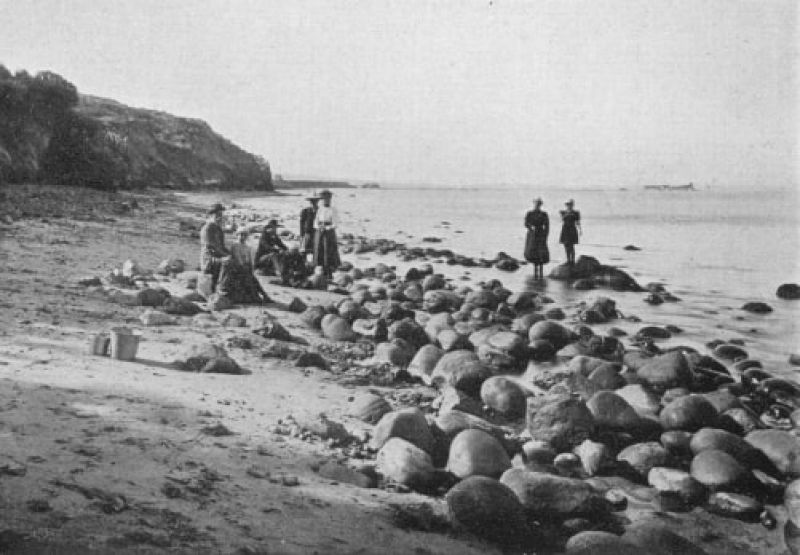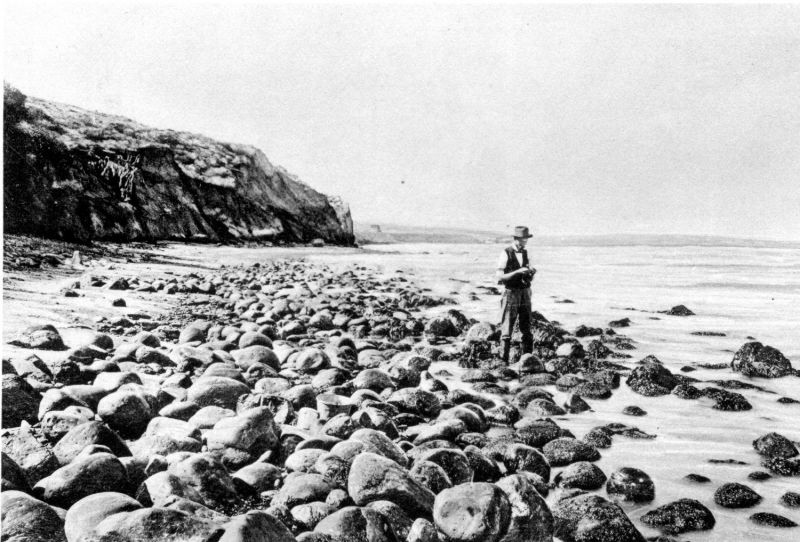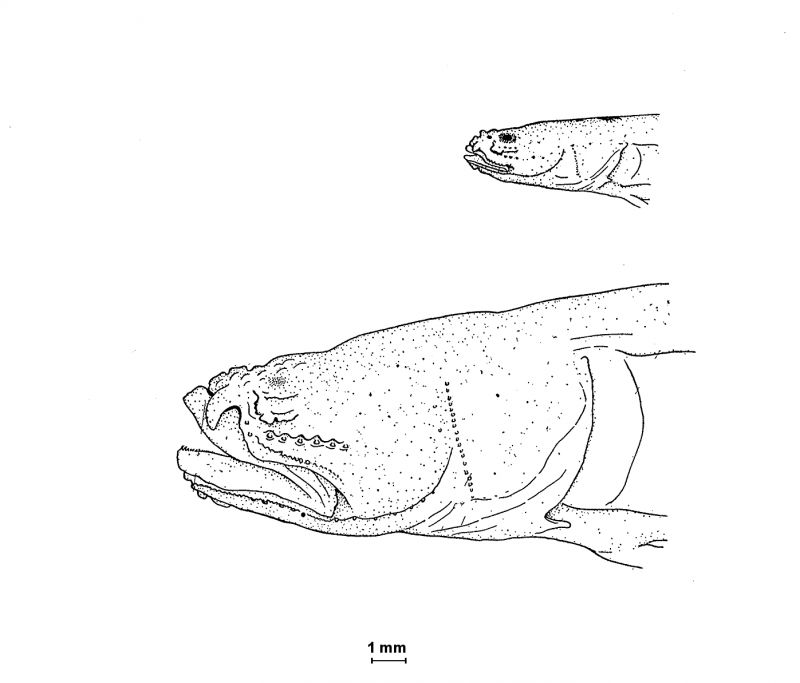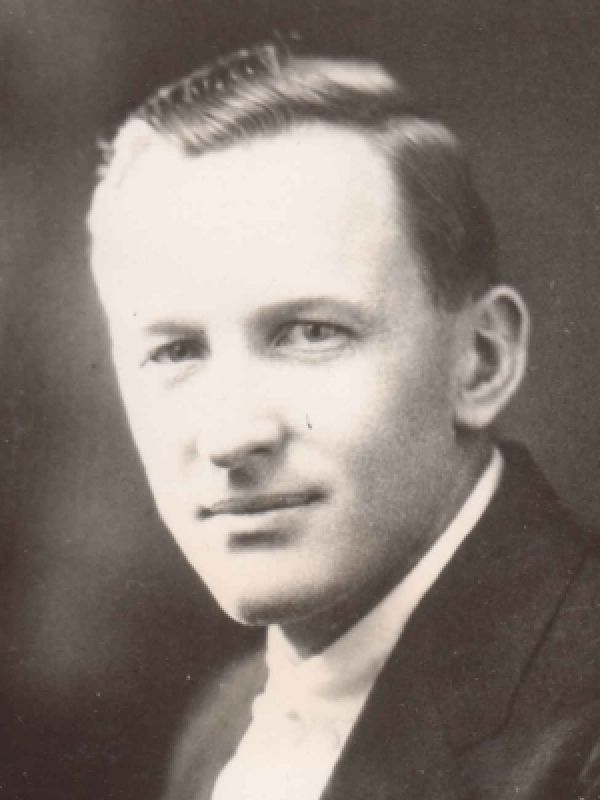Typhlogobius californiensis
Steindachner 1879

| ORDER | SUB-ORDER | FAMILY |
|---|---|---|
| Gobiiformes | Gobioidei | Gobiidae |
Note
As described below, Typhlogobius californiensis lives in a perpetual obligate relationship with a crustacean host with which it shares a burrow for most of its life, and in the wild it appears to be unable to live except in this symbiotic state. In captivity, with good conditions and sufficient food supplied, it can live without the host as shown by MacGinitie (1939). The host is so critical that it is also covered in detail in the following account.
The crustacean host of Typhlogobius californiensis was described as a new species, Callianassa affinis Holmes 1900, to differentiate if from another species, Callianassa californiensis Dana 1854, found in the same area. During research on the genus Callianassa for a Ph.D. thesis Biffar (1972) discovered that Callianassa affinis Holmes 1900 is a junior primary homonym of Callianassa affinis A. Milne Edwards 1860, which is a fossil species from the Lutetian of central France. To solve his immediate problem Biffar (1972) referred to the species as “Callianassa sp. A, new name”. No new name was forthcoming until Holthuis (1991) provided Callianassa biffari Holthuis 1991. In the same year, during the revision of the American Callianassidae, Manning and Felder (1991) errected the genus Neotrypaea to contain four American species (plus four others) which they deemed were not in the genus Callianassa. So the crustacean host is now called Neotrypaea biffari (Holthuis 1991) Manning and Felder 1991. [The citing of revising authors, in this case Manning and Fleder, after the bracketed original author is not common practice in zoological literature but is allowed by Recommendation 51G of the International Code of Zoological Nomencalture].
Over the c.120 years since its description the Crustacean host of Typhlogobius has been known by numerous names. The following list, which does not pretend to be complete, gives some of them.
Callianassa affinis by MacGinitie (1939), Zander (2012), Callianassa biffari by Ahnelt and Scattolin (2003), Thalianassa californiensis by Van Tassell (2011) Neotrypaea affinis by Ellingson et al. (2014), Trypaea biffari (superseded recombination)
Synonyms
Othonops eos Smith 1881
Country
USA: marineTypes
Only a Holotype was assigned: NMW 31175 50.2mm SL.
Distribution
Southern californian coast (USA), Santa Cruz Island (N) to San Diego (S) (Ahnelt and Scatolin 2003)
Baja california (Mexico) (Eschmeyer and Herald 1983)
Cabrillo National Monument, San Diego, California (Craig and Pondella 2006)
Todos Santos Bay B.C., Mexico (Ruiz-Campos and Hammann 1987)
Ensenada norte de San Simeon Poim, CA. E.U.A. a la Bahfa Magdalena, B.C. Sur, Mexico (Miller and Lea 1972)
Habitat
The relationship between the fish and crustacean host is usually referred to as either a symbiotic relationship or a commensal realtionship (e.g. McCosker 2006), with the following definitions of these terms being:
Symbiosis – A mutually beneficial partnership betweem organisms of different kinds (Chambers Dictionary 2008).
Commensalism – An organism living in partnership or association with another of a different species without affecting or benefiting it (Chamber Dictionary 2008).
It seems clear that, if we accept that the fish gains shelter while the crustacean is neither advantaged or disadvantages by the presence of two fishes in its burrow, we cannot consider it to be symbiosis. It also seems clear that we could use the term commensalism for this situation.
However, there are other terms available that allow a more refined and precise definition of how the two species involved are interrelating.
The term inquilinism (inquiline) is defined as:
Living in the home of, or in close association, of another (Chambers Dictionary 2008), or
The residence of individuals of one species within the nest of another species (Blackwelder and Garoian 1986:469), with the addition of three separate subterms which better define the nature of the association:
Symphile – Welcome guests that make some return to their host
Synechthran – Scavangers or predators tolerated or unsuccessfully challenged in the nest
Synoekete – Indifferently tolerated guests
It is clear that the relationship is not synechthran but it may be either of the other two. Although MacGinitie (1939), the principal authority on these animals, suggests that the fish make no return to the shrimps, he himself gives two examples which are clear, if small scale and possibly insignificant, assistances:
"Though, as has been stated before, the gobies will on occasion attempt to repel the invasion of other burrowing animals which may encroach upon their tunnels, they are not sufficiently aggressive to meet with much success in keeping out other animals. It is their hosts are ever on the alert to repel such invasions." (MacGinitie 1939:492,494).
"The clearing from the burrow of many of the larger particles of food is, so far as I have been able to determine, the only possible benefit that Callianassa may derive from the presence of the blind gobies, that is, the fish by their omnivorous habits clean up most of the material which enters the burrow and is not used as food by the shrimp." (MacGinitie 1939:494).
The latter point is also made by Karplus (2014), a significant authority on symbiotic relationships:
"MacGinitie (1939) often observed C. affinis carrying relative large pieces of organic matter, too large for the shrimp to ingest, and dumping them in front of the fish. The goby which ingested these particles acted as a sanitarian, saving the shrimp the necessity of dumping that material at the burrow entrance. This may be the only activity of the goby that benefits the shrimp, since the fish’s ability to expel intruders is, according to MacGinitie (1939), far below that of the shrimp." (Karplus 2014:312-313).
So the alternative we need to choose between are:
* No return from fish to crustacean the fish is a synoeketic inquiline
* With return from fish to crustacea the fish is a symphilic inquiline.
If we allow the above examples as assistances, even if of not that much help, then certainly the second of these terms is the better one to use. And it is certainly possible that there are other subtle and/or infrequent acts of return which MacGinitie missed, and since his time no-one else has studied this fish in any detail at all.
Systematics
Probably now most realistically placed in the Family Oxudercidae (a synonym of this, which will also be used in some sources, is Gobionellidae) (Nelson et al. 2016).
Thacker (2003): Within the expanded monophyletic gobionelline clade, two smaller clades are present: one containing both Mugilogobius x, Mugilogobius, Gillichthys mirabilis, Typhlogobius californiensis, C. annularis, E. newberryi, A. flavimanus, G. semivestita, P. lidwilli, and the kraemeriid K. cunicularia (clade IIA).
Chakrabarty et al. (2012) show that the nearest relative to T. californiensis (anong the species they tested) is Gillichthys mirabilis. Interestingly both of these species have additional breathing capillaries in the skin and operculum (Zander 2012).
Agorreta et al. (2013) found that Lethops connectens was sister species to a group containing Clevelandia ios, Eucyclogobius newberryi and Lepidogobius lepidus, and that Typhlogobius californiensis was sister to a group of these four. These specie are all in the Acanthogobius lineage of Agorreta et al. (2013).
Biological Notes
This species lives in burrows created by the Ghost Shrimp Neotrypaea biffari (Holthuis 1991) (Crustacea: Decapoda: Callianassidae) ; see below for a number of other names that have been used in the past). The first person to describe the relationship between Typhlogobius and the Crustacean appears to be Eigenmann (1917:175) where he says: "Under the boulders a crawfish-like crustacean has its burrows, and in these burrows lives a blindfish, Typhlogobius Californiensis." Hubbs (1927:287) says: "[Typhlogobius lives] in a most definite situation: namely, beneath stones, in the thus darkened burrows of a peculiar crustacean." It is not until the major study by MacGinitie (1939:489) that we get any idea what this crustacean is when he says: "This goby has lived so long in a burrow under the rocks with Callianassa aftinis Holmes, a shrimp that, like many other fish living in similar circumstances, it is, in the adult sta!ges, both blind and pink, having lost eyes and pigment." and he goes on to provide a detailed account of the habitat shared by the shrimp and the fish.
It is worth quoting Packard on some aspects of the biology of Typhlogobius:
"In his essay on the Fishes of San Diego, Professor Eigenmann briefly refers to and gives four figures (P1. XXIV) of the embryo of Typhlogobius, Mr C. L. Bragg having been fortunate enough to discover the egg in the summer of 1891. "The eyes develop normally, and those of Fig. 4 differ in no way from the eyes of other fish embryos." In this case, then, we have the simplest and clearest possible proof of the descent of this blind fish from individuals with eyes as perfect as those of its congeners. We have been permitted by the Director of the United States National Museum to reproduce Professor Eigenmanns excellent figures on the embryo, which tell the story of degeneration of the eye from simple disease of the organ, the species being exposed to conditions of life strikingly different from those of its family living in the same bay. Before the discovery of the eggs, the youngest individual ever seen is represented in PI. XXIII, fig. 7, its eyes being though small, yet distinct, and "apparently functional." Packard (1894)
DeMartini and SikkelI (2006) say: Known examples of monogamous California marine fishes are few and include a single species of extremely site-attached goby (the blind goby, Typhlogobius californiensis). The blind goby seems to exemplify small-bodied, siteattached, and relatively immobile species for which restricted access to mates has favored the evolution of monogamy. Monogamous pairs of blind gobies exhibit biparental care of demersal eggs within their burrow, and the species is apparently dioecious (MacGinitie 1939).
Conservation Status
MG [NE]
Museum Holdings
UCLA W 62-92 (cove north of San Simeon Point, identifier unknown, specimen pending accession at SIO, pers. comm. HJ Walker, Oct 2017) (Burton and Lea 2019).
USNM 27466 (I), USNM 34746 (4) (Birdsong et al. 1988)
SIO-87-26 N = 1 (Campos and Hammann ????)
Internet Resources
Genbank sequences for Typhlogobius
Smithsonian Institution specimen
EU450653.1 Unpublished. Gruenthal,K.M., Ellison,C.K., Tat,C.A., Walker,H.J., Hastings,P.A. and Burton,R.S.
DQ132488.1 Unpublished. Byrne,R.J., Walker,H.J., Hastings,P.A. and Burton,R.S.
GU440562.1 Unpublished. Hastings,P. and Burton,R.
Key References
The most critical sources of information on Typhlogobius are as follows:
Eigenmann (1890) - The Point Loma blind fish and its relatives
Ritter (1893) - On the eyes, integumentary sense papillae, and the integument of the San Diego blind fish (Typhlogobius californiensis Steindachner)
Eigenmann (1909) - Cave vertebrates of America, a study in degenerative evolution
Hubbs (1927) - The origin of the blind goby of the California reefs
MacGinitie (1939) - The natural history of the blind goby, Typhlogobius californiensis Steindachner. THE most important source
Coonfield (1942) - Development and reactions of melanophores of embryos and larvae of Typhlogobius californiensis Steindachner
Scheich et al. (1972) - Capillary dilatation in response to hypoxia In the brain of a gobiid fish
Congleton (1974) - The respiratory response to asphyxia of Typhlogobius californiensis (Teleostei: Gobiidae) and some related gobies
McNulty (1978) - A light and electron microscopic study of the pineal in the blind goby, Typhlogobius californiensis (Pisces: Gobiidae)
Ahnelt and Scattolin (2003) - The lateral line system of a blind goby, Typhlogobius californiensis Steindachner, 1879 (Teleostei: Gobiidae)
Ellingson (2012) - Phylogenetics and phylogeography of North Pacific bay gobies: adaptive convergence, relictual endemism, and climate-driven population structure
Ellingson et al. (2014) - Convergent evolution of ecomorphological adaptations in geographically isolated Bay gobies (Teleostei: Gobionellidae) of the temperate North Pacific
Karplus (2014) - Symbiosis in fishes: The biology of interspecific partnerships
All references
- Steindachner, F (1879)
- Smith, R. (1881)
- Packard, A. S. (1888)
- Eigenmann, R.S. (1890)
- Eigenmann, C.H. (1890)
- Eigenmann, C.H. (1892)
- Ritter, W. E. (1893)
- Packard, A.S. (1894)
- Holmes, S.J. (1900)
- Eigenmann, C.H. (1909)
- Eigenmann, C. H. (1917)
- Hubbs, C.L. (1926)
- Hubbs, C.L. (1927)
- Whitley, G.P. (1935)
- MacGinitie, G.E. (1937)
- MacGinitie, G.E. (1938)
- Lebour, M.V. (1938)
- Noble, E.R. (1939)
- MacGinitie, G.E. (1939)
- Noble, E.R. (1941)
- Coonfield, B.R. (1942)
- MacGinitie, G.E., and MacGinitie, N. (1949)
- Anonymous (1950)
- Laird, M. (1953)
- Dearolf, K. (1956)
- Dotu, Y. and Fujita, S. (1963)
- Breder, C.M. and Rosen, D.R. (1966)
- Luling, K.H. (1970)
- Miller, D.J. and Lea, R.N. (1972)
- Macdonald, C.K. (1972)
- Biffar, T.A. (1972)
- Hinegardner, R. and Rosen, D.E. (1972)
- Scheich, H., Honegger, H.W., Warrell, D.A. and Kennedy, G. (1972)
- Congleton, J.L. (1974)
- McNulty, J.A. (1978)
- Hoffman, C.J. (1980)
- Haig, J. and Abbott, D.P. (1980)
- Hoffman, C.J. (1981)
- Eschmeyer, W.N. and Herald, E.S. (1983)
- Ruiz-Campos, G. and Hammann, M.G. (1987)
- Birdsong, R.S., Murdy, E.O. and Pezold, F. (1988)
- Manning, R.B. and Felder, D.L. (1991)
- Holthuis, L.B. (1991)
- Thacker, C.E. (2003)
- Ahnelt, H. and Scattolin, G. (2003)
- Sakai, K. (2005)
- Craig, M.T. and Pondella, D.J. (2006)
- McCosker, J.E. (2006)
- DeMartini, E.E. and SikkelI, P.C. (2006)
- Kneer, D., Asmus, H., Ahnelt, H. and Vonk, J.A. (2008)
- Liu, H.T.H., Kneer, D., Asmus, H. and Ahnelt, H. (2008)
- Wirtz, P. (2008)
- Campos, E., De Campos, A.R. and Manriquez, I. (2009)
- Van Tassell, J.L. (2011)
- Zander, C.D. (2012)
- Zander, C.D. (2012)
- Chakrabarty, P., Davis, M.P. and Sparks, J.S. (2012)
- Ellingson, R.A. (2012)
- Agorreta, A., San Mauro, D., Schliewen, U., Van Tassell, J.L., Kovacic, M., Zardoy, R. and Rüber, L. (2013)
- Ellingson, R.A., Swift, C.C., Findley, L.T. and Jacobs, D.K. (2014)
- Karplus, I. (2014)
- Poore, G.C.B., Dworschak, P.C.,Robles, R., Mantelatto, F. and Felder, D.L. (2019)
- Burton, E.J. and Lea, R.N. (2019)
| Steindachner, F | Journal Article | 1879 | Ichthyologische Beiträge (VIII) |
| Smith, R. | Journal Article | 1881 | Description of a new gobioid fish (Othonops eos), from San Diego, California |
| Packard, A. S. | Book | 1888 | The cave fauna of North America, with remarks on the anatomy of the brain and origin of the blind species |
| Eigenmann, R.S. | Journal Article | 1890 | Note on Typhlogobius californiensis |
| Eigenmann, C.H. | Journal Article | 1890 | The Point Loma blind fish and its relations |
| Eigenmann, C.H. | Journal Article | 1892 | The Fishes of San Diego |
| Ritter, W. E. | Journal Article | 1893 | On the eyes, integumentary sense papillae, and the integument of the San Diego blind fish (Typhlogobius californiensis Steindachner) |
| Packard, A.S. | Journal Article | 1894 | On the origin of the subterranean fauna of North America |
| Holmes, S.J. | Journal Article | 1900 | Synopsis of California stalk-eyed Crustacea |
| Eigenmann, C.H. | Book | 1909 | Cave vertebrates of America, a study in degenerative evolution |
| Eigenmann, C. H. | Journal Article | 1917 | The homes of blind fishes |
| Hubbs, C.L. | Journal Article | 1926 | Notes on the gobioid fishes of California, with descriptions of two new genera |
| Hubbs, C.L. | Journal Article | 1927 | The origin of the blind goby of the California reefs. |
| Whitley, G.P. | Journal Article | 1935 | Studies in ichthyology. No. 9 |
| MacGinitie, G.E. | Journal Article | 1937 | Notes on the natural history of several marine Crustacea |
| MacGinitie, G.E. | Journal Article | 1938 | Notes on the natural history of some marine animals |
| Lebour, M.V. | Journal Article | 1938 | The newly-hached larva of Callianassa affinis Holmes |
| Noble, E.R. | Journal Article | 1939 | Myxosporidia from tide pool fishes of California |
| MacGinitie, G.E. | Journal Article | 1939 | The natural history of the blind goby, Typhlogobius californiensis Steindachner |
| Noble, E.R. | Journal Article | 1941 | On distribution relationships between California tide pool fishes and their Myxosporidian (Protozoan) parasites |
| Coonfield, B.R. | Journal Article | 1942 | Development and reactions of melanophores of embryos and larvae of Typhlogobius californiensis Steindachner |
| MacGinitie, G.E., and MacGinitie, N. | Book | 1949 | Natural history of marine animals |
| Anonymous | Journal Article | 1950 | Blind fish in California |
| Laird, M. | Journal Article | 1953 | The Protozoa of New Zealand intertidal zone fishes |
| Dearolf, K. | Journal Article | 1956 | Survey of North American cave vertebrates |
| Dotu, Y. and Fujita, S. | Journal Article | 1963 | The nesting behavior, egg development and larva of the gobiid Fish, Lubricogobius exiguus Tanaka |
| Breder, C.M. and Rosen, D.R. | Book | 1966 | Modes of reproduction in fishes |
| Luling, K.H. | Journal Article | 1970 | Uber die lebensweise des “Point-Loma- Blindfisches” (Typhlogobius californiensis) und seiner Verwandten |
| Miller, D.J. and Lea, R.N. | Journal Article | 1972 | Guide to the coastal marine fishes of California |
| Macdonald, C.K. | Thesis | 1972 | Aspects of the life history of the arrow goby, Clevelandia ios (Jordan and Gilbert), in Anaheim Bay, California, with comments on the cephalic-lateralis system in the fish family Gobiidae |
| Biffar, T.A. | Thesis | 1972 | A study of the eastern Pacific representatives of the genus Callianassa (Crustacea, Decapoda, Callianassidae) |
| Hinegardner, R. and Rosen, D.E. | Journal Article | 1972 | Cellular DNA Content and the evolution of teleostean fishes |
| Scheich, H., Honegger, H.W., Warrell, D.A. and Kennedy, G. | Journal Article | 1972 | Capillary dilatation in response to hypoxia In the brain of a gobiid fish |
| Congleton, J.L. | Journal Article | 1974 | The respiratory response to asphyxia of Typhlogobius californiensis (Teleostei: Gobiidae) and some related gobies |
| McNulty, J.A. | Journal Article | 1978 | A light and electron microscopic study of the pineal in the blind goby, Typhlogobius californiensis (Pisces: Gobiidae). |
| Hoffman, C.J. | Thesis | 1980 | Associative behavior of the Arrow Goby, Clevelandia ios (Jordan and Gilbert) and the Ghost Shrimp, Calliaassa californiensis Dana |
| Haig, J. and Abbott, D.P. | Book Section | 1980 | Macrura and Anomura: The Ghost Shrimps, Hermit Crabs and allies |
| Hoffman, C.J. | Journal Article | 1981 | Associations between the Arrow Goby Clevelandia ios (Jordan and Gilbert) and the Ghost Shrimp Callianassa californiensis Dana in natural and artificial burrows |
| Eschmeyer, W.N. and Herald, E.S. | Book | 1983 | A field guide to Pacific Coast fishes of North America from the Gulf of Alaska to Baja California |
| Ruiz-Campos, G. and Hammann, M.G. | Journal Article | 1987 | A species list of the rocky intertidal fishes of Todos Santos bay, Baja California, Mexico |
| Birdsong, R.S., Murdy, E.O. and Pezold, F. | Journal Article | 1988 | A study of the vertebral column and median fin osteology in gobioid fishes with comments on gobioid relationships. |
| Manning, R.B. and Felder, D.L. | Journal Article | 1991 | Revision of the American Callianassidae (Crustacea: Decapoda: Thalassinidea) |
| Holthuis, L.B. | Journal Article | 1991 | Marine lobsters of the world. An annotated and illustrated catalogue of species of interest to fisheries known to date |
| Thacker, C.E. | Journal Article | 2003 | Molecular phylogeny of the gobioid fishes (Teleostei: Perciformes: Gobioidei) |
| Ahnelt, H. and Scattolin, G. | Journal Article | 2003 | The lateral line system of a blind goby, Typhlogobius californiensis Steindachner, 1879 (Teleostei: Gobiidae) |
| Sakai, K. | Journal Article | 2005 | Callianassoidea of the World (Decapoda, Thalassinidea) |
| Craig, M.T. and Pondella, D.J. | Journal Article | 2006 | A survey of the fishes of the Cabrillo National Monument, San Diego, California |
| McCosker, J.E. | Book Section | 2006 | Symbiotic relationships |
| DeMartini, E.E. and SikkelI, P.C. | Book Section | 2006 | Reproduction |
| Kneer, D., Asmus, H., Ahnelt, H. and Vonk, J.A. | Journal Article | 2008 | Records of Austrolethops wardi Whitley (Teleostei: Gobiidae) as an inhabitant of burrows of the thalassinid shrimp Neaxius acanthus in tropical seagrass beds of the Spermonde Archipelago, Sulawesi, Indonesia |
| Liu, H.T.H., Kneer, D., Asmus, H. and Ahnelt, H. | Journal Article | 2008 | The feeding habits of Austrolethops wardi, a gobiid fish inhabiting burrows of the thalassinidean shrimp Neaxius acanthus |
| Wirtz, P. | Journal Article | 2008 | The Gulf of Guinea goby‐shrimp symbiosis and a review of goby‐thalassinidean associations |
| Campos, E., De Campos, A.R. and Manriquez, I. | Journal Article | 2009 | Intertidal Thalassinidean shrimps (Thalassinidea, Callianassidae and upogebiidae) of the west coast of Baja California, Mexico: annotated checklist, key for identification, and symbionts |
| Van Tassell, J.L. | Journal Article | 2011 | Gobiiformes of the Americas |
| Zander, C.D. | Book Section | 2012 | Gobies as predator and prey |
| Zander, C.D. | Book Section | 2012 | Morphological adaptations to special environments of gobies |
| Chakrabarty, P., Davis, M.P. and Sparks, J.S. | Journal Article | 2012 | The first record of a trans-oceanic sister-group relationship between obligate vertebrate troglobites |
| Ellingson, R.A. | Thesis | 2012 | Phylogenetics and phylogeography of North Pacific bay gobies: adaptive convergence, relictual endemism, and climate-driven population structure |
| Agorreta, A., San Mauro, D., Schliewen, U., Van Tassell, J.L., Kovacic, M., Zardoy, R. and Rüber, L. | Journal Article | 2013 | Molecular phylogenetics of Gobioidei and phylogenetic placement of European gobies |
| Ellingson, R.A., Swift, C.C., Findley, L.T. and Jacobs, D.K. | Journal Article | 2014 | Convergent evolution of ecomorphological adaptations in geographically isolated Bay gobies (Teleostei: Gobionellidae) of the temperate North Pacific |
| Karplus, I. | Book | 2014 | Symbiosis in fishes: The biology of interspecific partnerships |
| Poore, G.C.B., Dworschak, P.C.,Robles, R., Mantelatto, F. and Felder, D.L. | Journal Article | 2019 | A new classification of Callianassidae and related families (Crustacea: Decapoda: Axiidea) derived from a molecular phylogeny with morphological support |
| Burton, E.J. and Lea, R.N. | Journal Article | 2019 | Annotated checklist of fishes from Monterey Bay National Marine Sanctuary with notes on extralimital species |



